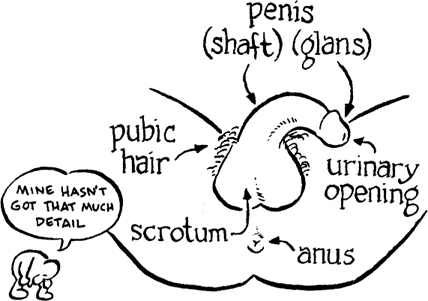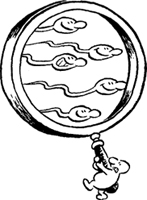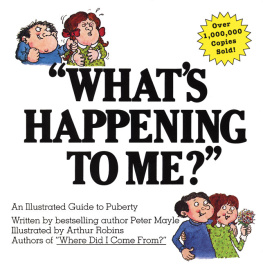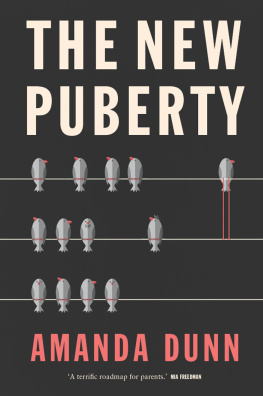What's Going on Down There?

What's Going on
Down There?
Answers to Questions Boys Find Hard to Ask
Karen Gravelle
with Nick and Chava Castro
Illustrations by Robert Leighton

Without the help of the men and boys who shared their thoughts and experiences about puberty with me, this book would have been much shorter and a lot less interesting. Thank you all! Thanks also to Dr. Ingeborg Schraft-Hoffman and Dr. Radoslav Jovanovic for their assistance.
Text copyright 1998 by Karen Gravelle
Illustrations copyright 1998 by Robert Leighton
All rights reserved. No part of this book may be reproduced or transmitted in any form or by any means, electronic or mechanical, including photocopying, recording, or by any information storage and retrieval system, without permission in writing from the Publisher.
First published in the United States of America in 1998
by Walker Publishing Company, Inc.
Published simultaneously in Canada
by Thomas Allen & Son Canada, Limited, Markham, Ontario
Library of Congress Cataloging-in-Publication Data
Gravelle, Karen.
What's going on down there?: Answers to questions boys find hard to ask/Karen Gravelle, with Nick and Chava Castro; illustrations by Robert Leighton.
p. cm Includes index.
Summary: Describes the physical and emotional changes that occur in boys (and, to a lesser extent, in girls) during puberty and discusses sexual activity, homosexuality, AIDS, and other related topics.
eISBN: 978-0-802-72131-0
1. Teenage boys-Physiology-Juvenile literature. 2. Puberty-Juvenile literature. 3. Sex instruction for boys-Juvenile literature [1. Puberty. 2. Sex instruction for boys.]
I. Castro, Nick. II. Castro, Chava. III. Leighton, Robert, illustrator.
IV. Title.
RJ143.G73 1998
612.6'61-dc2198-3686
CIP
AC
Book design by Dede Cummings
Printed in the United States of America
25 27 29 30 28 26
Contents
A Note from Karen
with Nick and Chava
S ince I'm not a guy, I wasn't sure exactly what concerns boys who are going through puberty might have. So I decided to ask some expertsthirteen-year-old Chava Castro and his eleven-year-old brother, Nick. Chava and Nick both had sex education in their school, but they felt that many of their questions didn't get answered. There were other things they wondered about but didn't want to bring up in public. Therefore, they thought a book like this was a very good idea and agreed to help me write it. Here's what they had to say about working on What's Going onDown There?
Chava: I really had fun working on this book, and I learned a lot! In my sex education class, the teacher never told us (and the books didn't either) that you can't ejaculate and urinate at the same time. That was not a good thing to leave out! I was really worried about this until I finally asked my mom. It was also a relief to learn that guys have emotional times during puberty and that I wasn't weird for feeling this way. This book will be great to read in private, because I'd be really embarrassed to ask questions in class. Everyone would laugh or tease me for sure!
Nick: I liked helping to write this book because sex ed in the fifth grade didn't explain enough about my body. I'm lucky that my mom is a nurse, but by working on the book I thought of things that I forgot to ask her that have confused me sometimes. Asking your friends isn't always the best way to find out, because they can have some strange information sources. At least now I know that all guys go through these changes, not just me.
What's Going on Down There?
If you're a boy somewhere between ten and fourteen years old, you probably don't need a book to tell you that your body is starting to change. Even if you haven't noticed much of a difference in yourself yet, chances are you've seen changes occurring in some of your friends.

For example, guys who used to be your height may suddenly have gotten much taller than youor perhaps you're the one who's now towering over the other boys in your class. Some of you may have noticed that your shoulders are getting broader and your whole body seems more muscular. For the first time, dark hairs may be starting to grow under your arms and on your lips. Most of the time, boys your age look forward to these changes or at least feel OK about them.
But other changes may not be so great, which is one reason that some boys wonder if growing up is such a good thing. A lot of guys begin to develop bumps on their faces, and there isn't a person alive who likes having pimples. Or, right in the middle of a normal conversation, your voice may suddenly become high and squeaky.
These changesboth the ones you want and the ones you don'tare things that other people can see. But some of the most important changes are ones that only you are likely to notice. For example, around age eleven or twelve, give or take a little, a boy's penis begins to look different, feel different, and even act different.
What's Going on Down There? will help you understand all of these changes-what causes them, when to expect them, and how to handle those that concern you. All of these changes are connected; they all have to do with the fact that you are becoming a man. So let's start with the things that make you a male in the first place.
T he things that make a person male or female have to do with reproduction, or having children. Therefore, these differences involve the genital, or sexual, organsthe parts of the body that make it possible for a person to reproduce.
As you probably know, it takes both a man and a woman to create a baby. That's because half the instructions necessary to form a baby's body come from the man and half from the woman. These instructions are contained in a man's sperm and in a woman's eggs. A sperm and an egg must unite inside a woman's body for a baby to develop. We'll talk about how all this happens in chapter 6. But right now, let's concentrate on your genitals, the organs that make you a male.
The Genitals
Some of a boy's genitals, such as his penis and testicles, are easy to see because they are large and placed out in the open. But you also have several internal opening reproductive organs that you probably haven't been genital organs, whether aware of. All of your genital organs, whether they are inside or outside your body, play a part in making you able to have children.

Testicles and Scrotum
The testicles are two nut-shaped organs that hang in a sac of wrinkly skin between a male's legs. Their job is to produce sperm. Sperm are tiny cells that look like little tadpolesif you could see them, that is. Sperm are so small they're visible only through a microscope. Like tadpoles, they have tails that enable them to swim.

The sac that contains the testicles is called the scrotum. Since young boys don't have sperm, their testicles and scrotum are small. But as a boy begins to become a man, these organs start to grow and his testicles begin to make sperm.
Next page










